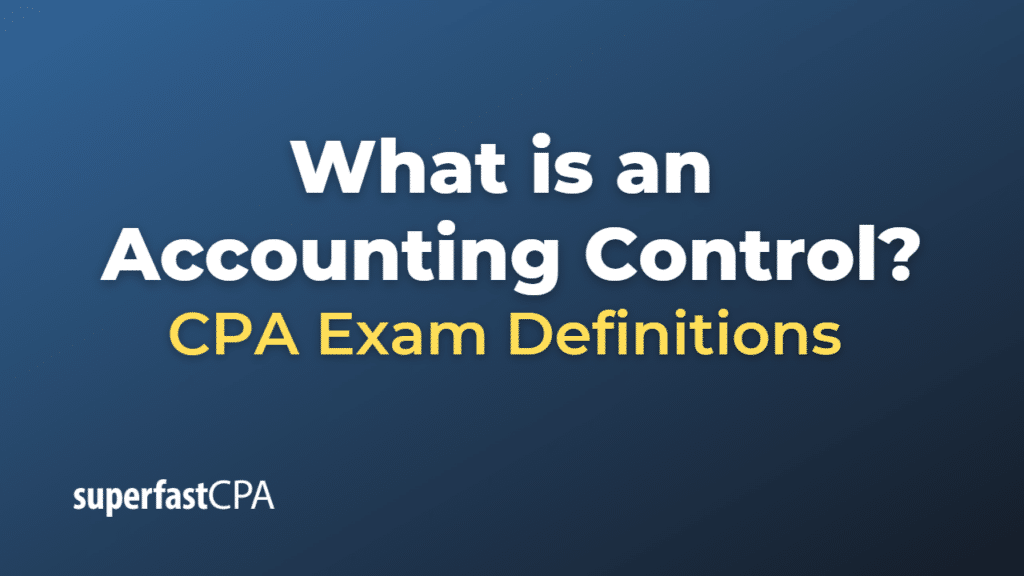Accounting Control
Accounting control, also known as internal control or financial control, refers to the policies, procedures, and systems put in place by an organization to ensure the accuracy, reliability, and integrity of its financial information, safeguard its assets, promote operational efficiency, and encourage adherence to established policies and regulatory requirements.
Accounting controls can be classified into two main categories:
- Preventive controls: These controls are designed to prevent errors or irregularities from occurring in the first place. Examples of preventive controls include segregation of duties (e.g., separating the responsibilities for authorizing transactions, recording transactions, and maintaining custody of assets), approval and authorization procedures, physical control over assets (e.g., locked storage rooms or safes), and pre-numbered documents (e.g., invoices and checks).
- Detective controls: These controls are designed to identify errors or irregularities after they have occurred, facilitating their timely correction or investigation. Examples of detective controls include reconciliations (e.g., bank reconciliations, account reconciliations), regular review and analysis of financial reports, variance analysis, internal audits, and exception reporting.
An effective accounting control system typically involves a combination of both preventive and detective controls. These controls can be further classified as manual or automated, depending on whether they are performed by individuals or computer systems.
Accounting controls play a crucial role in mitigating the risk of fraud, errors, and misstatements in financial reporting. They also help organizations maintain compliance with laws and regulations, such as the Sarbanes-Oxley Act in the United States, which requires public companies to establish and maintain a system of internal controls over financial reporting.
Implementing and maintaining robust accounting controls is the responsibility of an organization’s management, with oversight from the board of directors and audit committee. Periodic evaluation of the effectiveness of accounting controls is essential to ensure that they continue to address the organization’s risks and evolving business environment.
Example of an Accounting Control
Let’s consider a fictional retail company called “ShopMart” to illustrate the application of accounting controls in practice.
ShopMart has implemented various accounting controls to ensure the accuracy and reliability of its financial information, safeguard its assets, and promote operational efficiency. Some of these controls include:
- Segregation of duties: ShopMart separates the responsibilities of approving purchase orders, receiving goods, and processing payments. This segregation of duties reduces the risk of fraud and errors by ensuring that no single employee has control over the entire purchasing process.
- Authorization and approval: ShopMart requires management approval for all significant expenditures, such as large inventory purchases, capital expenditures, or new contracts. This control helps ensure that expenditures align with the company’s budget and strategic objectives.
- Physical control over assets: ShopMart maintains physical control over its inventory by implementing security measures, such as locked storage rooms, surveillance cameras, and access controls. This helps prevent theft and unauthorized access to the company’s assets.
- Reconciliations: ShopMart regularly reconciles its bank accounts, accounts receivable, and accounts payable to ensure the accuracy and completeness of its financial records. These reconciliations help identify discrepancies or errors that may require further investigation or correction.
- Variance analysis: ShopMart’s management periodically reviews the company’s financial performance, comparing actual results against budgets and forecasts. By analyzing variances, management can identify potential issues, such as unexplained revenue declines or cost overruns, and take corrective action as needed.
- Internal audits: ShopMart conducts periodic internal audits to assess the effectiveness of its accounting controls and identify areas for improvement. Internal auditors may review various aspects of the company’s operations, such as inventory management, cash handling, or financial reporting processes.
In this example, ShopMart implements a combination of preventive and detective accounting controls to mitigate risks and ensure the accuracy, reliability, and integrity of its financial information. By maintaining robust accounting controls, ShopMart helps protect its assets, enhance operational efficiency, and maintain compliance with relevant laws and regulations.













